How to Cook for Odysseus
And the old king burned these over dried split wood
and over the fire poured out glistening wine
while young men at his side held five-pronged forks.
Once they’d burned the bones and tasted the organs,
they sliced the rest into pieces, spitted them on skewers
and raising points to the fire, broiled all the meats.
— In Nestor’s Palace, The Odyssey
"The thing I have noticed is when the anecdotes and the data disagree, the anecdotes are usually right. There's something wrong with the way you are measuring it."
— J. P. Bez
Dear friends,
Health is not merely about one’s diet, but it feels like a natural place to start. What follows are a few beliefs of my own.
~ ~ ~
Occasionally studies (or articles about studies) get circulated with titles like: The Sleep Patterns of Tribal People and What We Can Learn From Them. Perhaps you’ve seen one or two of these. The studies sort-of assume that an exotic group of people must have something clever figured out, and that scientists can deduce their secrets by observation. If there is one primary belief I want to convey, it is that
(here I inhale)
YOU DON’T NEED TO BE THE STUDY READER OR THE STUDY MAKER.
YOU CAN BE THE TRIBAL GUY.
You can experiment and observe yourself to find out what works.
Nutrition and health studies are often poor, the research institutes often compromised or lazy, the authority figures in the field notoriously unknowledgeable, and occasionally evil. In general the average cashier at a grocery store has a better grasp of cause-and-effect nutrition than the average health researcher, not only because their knowledge on the ground is superior, but because they’re never paid to lie.
Reliance on food surveys tarnishes a large portion of nutrition science data, and continues to do so, despite researchers acknowledging that they’re garbage. Lots of food research follows essentially this pattern:
SURVEY: How many "servings" of "meat" did you eat last week?
[Person who ate 4 steaks]: 4
[Person who ate fried breaded bread with condiment levels of meat daily]: 12
RESEARCHER: "Gentlemen, through Science I have discovered that meat is unhealthy."
So in this realm, your own experimentation and observation matter. Even if you’re not a grocery store clerk, you should be able to make observations about society (for example, 60 years of a war against butter, red meat, and eggs, has not seemed to make people healthier) and your own body (you might feel great if you eat far more butter and red meat and eggs).
~ ~ ~
Eat nutrient-dense animal products, cooked yourself, with plenty of fat
If I can compact my beliefs here into a sentence: By percent of calories, an ideal diet consists mostly of nutrient dense animal products, like eggs, skyr (thick, protein and fat rich yogurt), cheeses, meats, especially red meat, butter, cream, tallow, salami, small fish, and offal. The highest quality you can afford. You should eat other things too, but you should try to get a significant amount of your calories from these dense sources.
Foods towards the top are meaningful sources of nutrition. The stuff near the bottom is essentially filler or condiments. There is nothing wrong with eating the lower foods, and some of them are probably quite beneficial. On the basis of what we do not know it is probably good to have a varied diet, because there are doubtless other meaningful nutrients than the ones we’ve easily identified. But to eat in a healthy way means ensuring one gets their calories from primarily nutrient dense, high quality foods.
Note how far down chicken is on the list. There’s a recent (~20 years) fixation on macronutrients — protein, fat, carbs — which are an important concept, but do not easily capture differences in quality between sources. This is especially true today, where people have options like engineered fake meat, which by the nutrition label macros may look comparable to real meat, but they tend to get there in very different ways, chemically. Experimentation is good but I am suspicious of being an early adopter with one’s body. I hope the difference is clear.
This nutrient density matters more than most other principles in diet discourse, and as a guiding principle it easily answers most lesser questions of nutrition for you.
Eat as elemental as possible, and cook your own food. You should know all the inputs.
From a dietary perspective food is best reasoned about as ingredients, not finished products. It’s a significant problem today that most people do not know what is in the food they are eating. You could ask 10 people if they ate soybean oil in the last week and all 10 might say no, while in fact all 10 of them actually have. This is surprisingly typical! It is also, again, why food surveys are so useless.
A McDonald’s chicken nugget is 61% grains and low quality oils, 39% chicken. Most people think they are eating chicken. They are eating bread mixed with chicken, covered in bread, fried (according to the website) in: "Canola Oil, Corn Oil, Soybean Oil, Hydrogenated Soybean Oil". These are a high calorie, low nutrient density product. Chicken is already the filler of the meats, and even that is being displaced by these much poorer fillers.
In prepackaged and restaurant food, nutrient dense sources have been replaced with filler
You might not eat at McDonalds, but the nugget is a microcosm of what’s happened to a large number of foods, especially prepackaged foods, from whole meals down to salad dressings and sauces and other components. Even simple foods like the humble tortilla, which were traditionally made with lard, or sauces traditionally made with olive oil, are now almost all made with vegetable oils instead. In the case of lard, butter, and tallow, this is partly catering to vegetarian or vegan sensibilities, but mostly it is cost reduction for the companies that make processed foods. This creates incentive for food companies to latch on to the ideas of vegetarianism and veganism as healthy, regardless of how flimsy those claims may be, because the PR is very self-satisfying. In reality vegetable oils are simply a much easier supply chain and a better profit margin. Restaurant chains have followed suit, and many mediocre chains such as Uno use no butter at all, but instead a “butter alternative that is dairy free” (soybean oil). If the company is not trying to hide it, or has to reveal it on a website, the language almost always tries to couch the substitution as a good thing.
This mass removal of nutrient dense animal foods in favor of plant-based, low quality (but similar calorie) alternatives can be seen compactly in these two graphs:
Actually one more graph, a photo someone took it during a talk at the International Society for Nutritional Psychiatry Research in 2017:
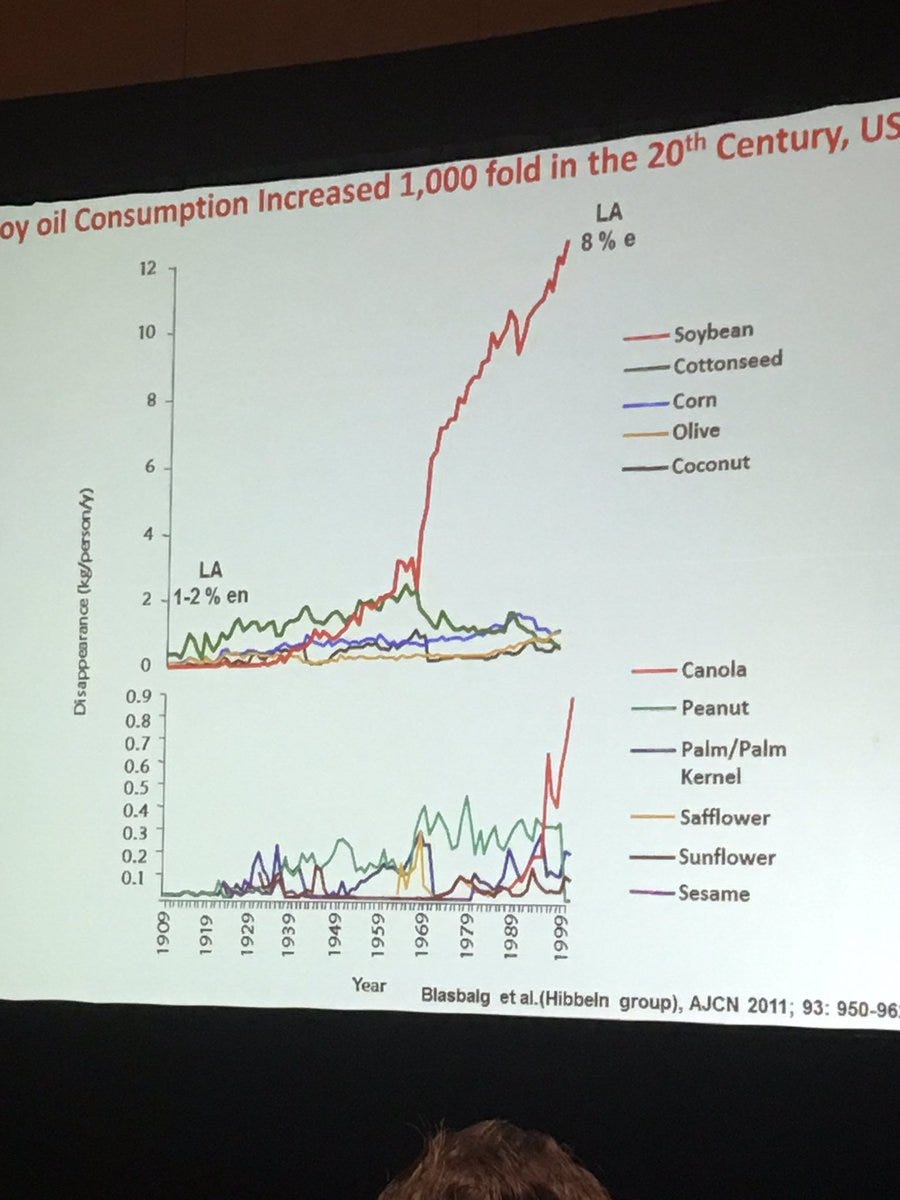
It is not an exaggeration to say that these graphs show some of the biggest changes to the human diet since the invention of agriculture. It should spook you a little.
You should look at any bought baked or frozen goods, jars of pasta sauce or salad dressing or chips or whatever else you have in your pantry and fridge and see which of them today have canola or soybean oil where they did not 30 years ago. Depending on how fastidious you are about this already, it may be much more than you think.
The problem with modern eating and by extension the obesity epidemic is probably largely laid at the feet of these graphs and the decision to drive out high quality animal fats in favor of very low quality plant fats. Though just why one would lead to the other, the mechanisms of action in other words, are varied and somewhat speculative. But again with my first point, you don’t need to know 100% why in order to change your behavior (or to observe obesity rates). You don’t need to prove anything in order to decide to eat differently, just as people in the 1850s didn’t need to prove that butter was good before eating it. I will try to give very brief mention to obesity causes near the end.
~ ~ ~
I buy butter 12 pounds at a time for my family of 2 adults and 2 babies. We eat great quantities of it, and to some friends it seems like extraordinary quantities. But it is a fairly unremarkable consumption pattern by historical standards. If you had a family cow, during its cycle it would be producing 4-9 gallons of milk per day, thousands of gallons per cycle. Cheese and butter-making began as a way to extend the life of this food, and actually ended up making significantly better products.
Aside but related: while some days I get ~30% of my calories from dairy, I believe milk is probably the worst of the dairy sources of nutrition. Cheese, yogurt, and other dairy fermented products are better because they do not produce the mild oxidative stress response that milk seems to in many people when drank in large amounts. I tend to eat lots of Siggi’s 4% and Fage 5%, buying 4 to 8 containers at a time.
Tallow (beef fat) too used to be consumed in great quantity: Before refrigeration, tallow was the primary product of the cattle industry, since it stored so well, not the meat. Today a lot of tallow is simply thrown out since no one wants it. This is a great shame, since it’s a very high quality source of fat. It was the case that McDonalds used to fry their fries in tallow, until 1990 when they were more or less bullied out of it by Phil Sokolof, who almost single handedly got McDonalds to switch away from tallow to pure vegetable oil. In this post he can be thought of as something of a spiritual arch-enemy (He thought tallow was unhealthy compared to plant oils, thought 2% milk was “too fatty”, and died from heart failure. I wonder why.)
I think when you make French fries at home you should be using tallow. When you make buttered toast you should be seeing teeth marks in your butter, or you’re using much too little. Whole milk in the US is too lean, they are removing fat from it, best to add it back with some heavy cream. Even better, if you eat something with lots of milk (like cereal), it should actually be mostly skyr, with some milk stirred in.
~ ~ ~
Condiments versus food, “Eating fruits and vegetables”
A meme image, with many variations, all of which are silly and flawed:
This is not why kids are obese, they are obese because the item on the left is bread, and the item on the right is — if we’re lucky — 5 calories. If we’re unlucky the picture on the right is coated in sugar and canola or soybean oil.
Neither of them are actually a meal. They are simply not enough calories to be a meal.
If you order a burger and small fry from McDonalds the total, with no extra sauces, comes to 480 calories. The burger part of that is 250 calories, the actual beef part is just 90! The problem with this popular hamburger is not that it is a hamburger, but that it is not enough hamburger. Never mind the meat quality, 90 calories of real food and 390 calories of filler is simply a poor meal, and if you eat that you can expect poor results. (In practice people order much more, and the burger itself can be even worse: many fast food burgers have more than 90 calories of sauces added, too, and many “cheeses” including McDonald’s are part soy oil.)
You don’t need to worry about calorie totals if you are optimizing to get as many high quality calories as possible (beef eggs yogurt butter etc). You can make extraordinarily healthy burgers and fries if you have enough beef and tallow, and cheese, and (hopefully) excellent bread. Salad is a fine accompaniment or condiment but good diet should never be about restricting yourself with bouts of non-food passed off as food.
The condiment-levels-of-meat burger is an adjacent problem to the person who thinks that to lose weight and get healthy they simply need to “eat more fruits and vegetables.” Fruits and vegetables are for the most part condiments. They do not have enough calories or density to make very meaningful meals. If you are trying to substitute real quantities of food for an apple and a salad you are going to be hungry and your body will want more, and your body is correct. In addition you cannot shore up a diet by adding some healthy-looking or sounding components. A poor diet plus wheatgrass juice and acai berries (or whatever’s in fashion) does not make it good. Health is always a system, not a component or series of components.
A healthy diet should feel like one of abundance. Food should feel as joyous and vital as it is in Nestor’s palace. There is no need to regularly starve or restrict yourself, even to lose weight. It is only important that the abundance must be high quality, calorie and nutrient dense food, as often as it can be. Or else it will come as no surprise that you’re hungry one hour after eating fried breaded bread or a lettuce as a meal.
This frame — of food as abundance, partaking in a joy and prosperity — is not easily conveyed in a letter. Like much of how to live, it is best experienced side by side with others in daily life. But it is important enough that I feel I should mention it regardless, because it is one of my strongest beliefs. Your diet should feel good, like you are gaining strength, and not like some punishment.
~ ~ ~
I have tried to summarize and justify a few points I consider very simple, almost obvious, so I hope they are both quite clear and that I have not overdone things.
Now a few loose ends to tie up.
Carbs: Are they bad?
Avoiding carbs is, at least, a decent heuristic for avoiding low quality food. And carb-rich things can spike your blood sugar, which can (in theory) lead to fat storage and making you hungry again soon afterwards.
If you are eating mostly beef, eggs, yogurt, butter, etc, you’ll naturally be eating fewer carbs anyway. For breakfast almost every morning my wife and I eat 7-8 eggs (ideally from our own chickens) scrambled in butter and Siggis 4% yogurt, with home-made bread that we bake once or twice a week. And on the bread of course, enough butter to have toothmarks. In other words: Eggs and butter, with condiment levels of bread.
People occasionally claim that carbs/sugar are responsible for the obesity crisis, but these seem to be going down as a % of diet in the last decade or more, so they are probably not the whole reason. I think it likely that it is a combination of:
People have a difficult time realizing just how much they are eating. For example, the calories drank in soft drinks and sugary cafe drinks is often far larger than people realize. This does track with carbs, technically. But it’s also easily hidden from food surveys.
Very low quality fats that have replaced high quality ones.
Seed oils: Are they bad? (and why red meat is so good)
When people talk about this they are mostly talking about omega-6 polyunsaturated fatty acids, aka PUFA, specifically linoleic acid (LA). A lot has been said about these lately and it’s probably not worth adding too much fuel to that bonfire, so I will keep this to two short points.
Seed oils are, at best, low quality fats, and you should avoid eating big quantities of them, which means you should avoid most prepackaged food and most restaurants. With that said if you are not getting huge amounts of calories from them, they are probably not terrible. I do not think some sesame oil in your homemade stir fry will have any ill health effects.
There is one very interesting mechanistic reason they may be bad in great quantities, other than their mere low-nutritional-value. Linoleic acid (LA) is what prompts mammals to enter torpor, the state that gets them ready for hibernation by packing on the pounds. For example squirrels must consume a big quantity of acorns which contain enough LA to enter this state. Humans despite being mammals are not thought of as hibernators or entering torpor. This may be a mistake. It may be that our massive LA-increased diet is what’s causing so many overweight people to put on and keep on the pounds. Drew Schorno wrote an interesting post about this called Bear Nation, and it seems plausible. You should note also that consuming small amounts of LA may actually have the opposite effect, and slightly promote weight loss, so total avoidance is again probably not a big deal here. If you are interested at all in obesity you should read Drew’s full post.
Red meat is better than pork or chicken because ruminant diets (cows, goats, sheep), even if they are given PUFA in feed, tend to have far less PUFA in the resulting product because they metabolize it into saturated fat. With pork and chicken meat it is not so, and they are a lot closer to “what you put into it is what you get out.” You can trust that the average farm is optimizing for cost in their animal feed, so by default, red meat has a quality advantage over the others. Chicken is already lower in nutrient density, but this is the other good reason to prefer beef and lamb instead as primary meat sources.
Vegetarianism and Veganism
Are diets of deficiencies. Some people actually feel very good for a few weeks when switching to veganism because of this, because it can be eating so clean that it’s a kind of pseudo-fasting. But beyond this blip, everything necessary for health and especially brain health is found in greater bioavailability and quantities in animal sources.
Poor diets especially in children are so bad that I believe many children with autism-like symptoms actually have B12 deficiencies, as this is not an uncommon sight in medical literature. I’ve mentioned that before, and I think anyone with children should take the brain damage concerns of insufficient B12, EPA/DHA, and other primarily-animal nutrients very seriously. I suspect in 50 years we may be horrified at the damage of novel vegan diets.
We are very lucky as a society that vegetarians at least have no qualms about eating eggs (which always struck me as a little weird, since lots of exclusive carnivores, like snakes, are happy to subsist off of eggs. Don’t bring it up to vegetarians. Eggs are better than nothing).
Aren’t you worried about cholesterol?
No, and it’s probably no surprise that the overemphasis on it coincided with an obesity and heart disease explosion. What is easy to measure is not necessarily useful, and what’s worse, it seems to have stuck around as a point of misinformation among even health professionals.
In a 2015 Credit Suisse Foundation survey of doctors they found that 54% of them falsely believed eating cholesterol-rich food raises blood levels of cholesterol. That most doctors would get something known for decades so wrong about a topic like cholesterol should give everyone pause. Being charitable, it’s a clear example of misinformation among doctors that’s merely a result of the decades-long war on butter and eggs. Being less charitable: How on earth do all doctors not know this by now? It would be like if civil engineers largely believed that concrete had more tensile strength than compressive strength, and many of their clients were getting more and more faulty results like falling bridges, and the engineers simply didn’t care.
Inability to understand the basics casts some doubt on the advice or effectiveness of doctors as a group to understand nutrition. You’re quite possibly better off listening to a rando who goes to the gym and talks to other gym goers about their diet, or the grocery store cashier. In many cases being misinformed is more dangerous than being uninformed (the well-informed for decades claimed that trans fat was much healthier than butter, too, which thankfully everyone now knows is false.) This is as I’ve said before the perennial problem of bad science in the modern era. Doctors and US guidelines both need to make up for seemingly not caring about the topic.
The USA is obsessed with cholesterol I suspect almost solely because of how easy it is to measure, and how easy it is to prescribe something. Actual cholesterol research generally is all over the place. There’s an interesting but long 2015 Japanese Supplementary Review on Cholesterol and Mortality Rates: It suggests that higher total or LDL cholesterol correlates with longer life, and better cognition (your brain is made out of cholesterol, by the way).
The review concludes:
Our fervent wish is that, through this supplementary issue, people can see that the cholesterol hypothesis relies on very weak data—and sometimes considerably distorted data. Indeed, many studies in Japan actually show that cholesterol plays a very positive role in health. We hope that JAS, and the government authorities that defer to JAS’s recommendations, will move toward recognizing cholesterol as a friend not an enemy. In the meantime, we will continue pushing for acceptance of the anti-cholesterol hypothesis, to reverse what we see as the biggest mistake made by medical science in the previous century.
~ ~ ~
This is a summary of a few of my beliefs around diet. It is not all of them, and you should take it as a filter, not a sponge. Most important is still this: If you want to be healthy and vital you should ask healthy and vital people you admire about their diets and lives, and you should experiment yourself.
Ever yours,
s s
Appendix and notes
— In my quoted scene of The Odyssey, Nestor was actually feeding the son of Odysseus, Telemachus. But more people are familiar with the name Odysseus, so I felt the title more appropriate.
— J. P. Bez is better known by his preferred name, Jeff Bezos
— The first image is from Priority Micronutrient Density in Foods by Ty Beal and Flaminia Ortenzi
— On the basis of what we do not know… — A phrase I read in James Scott’s Seeing Like a State that I can’t help repeating constantly.
— …but they [fake meats] tend to get there in very different ways, chemically — See Stephan van Vliet’s paper, A metabolomics comparison of plant-based meat and grass-fed meat indicates large nutritional differences despite comparable Nutrition Facts panels. His work suggests that comparable meat and fake meat may have similar macros but completely different metabolite profiles.
— It is also, again, why food surveys are so useless. — For example in the 1992 paper Discrepancy between self-reported and actual caloric intake and exercise in obese subjects, subjects underreported their food intake by 47%, plus or minus 16%. And these were people who knew they were in a study!
— The two Animal/Vegetable fat graphs are from United States Dietary Trends Since 1800: Lack of Association Between Saturated Fatty Acid Consumption and Non-communicable Diseases
— …because they do not produce the mild oxidative stress response that milk seems to — this belief is partly based on a Swedish study of milk drinkers, Milk intake and risk of mortality and fractures in women and men: cohort studies. It found that the elderly who drink a lot of milk, at least the women, tended to have more bone fractures, but also states that every other dairy product had the opposite effect: “Particularly noteworthy is that intake of fermented milk products such as yogurt and soured milk and cheese were associated with lower rates of fracture and mortality.” They suppose this comes down to the D-galactose, which is found in non-fermented milk.
For being a cohort survey study, I like this Swedish paper because of its fairly strict focus on dairy, and because they tried to corroborate the food survey results with biomarkers: “Furthermore, in both sexes we have found a positive association between reported intake of milk and the fat tissue content of pentadecanoic acid, a biological marker reflecting average long term intake of milk fat” This is, for a change, good science.
~ ~ ~
The engraving is anonymous circa 1805, after John Flaxman, 1755–1826


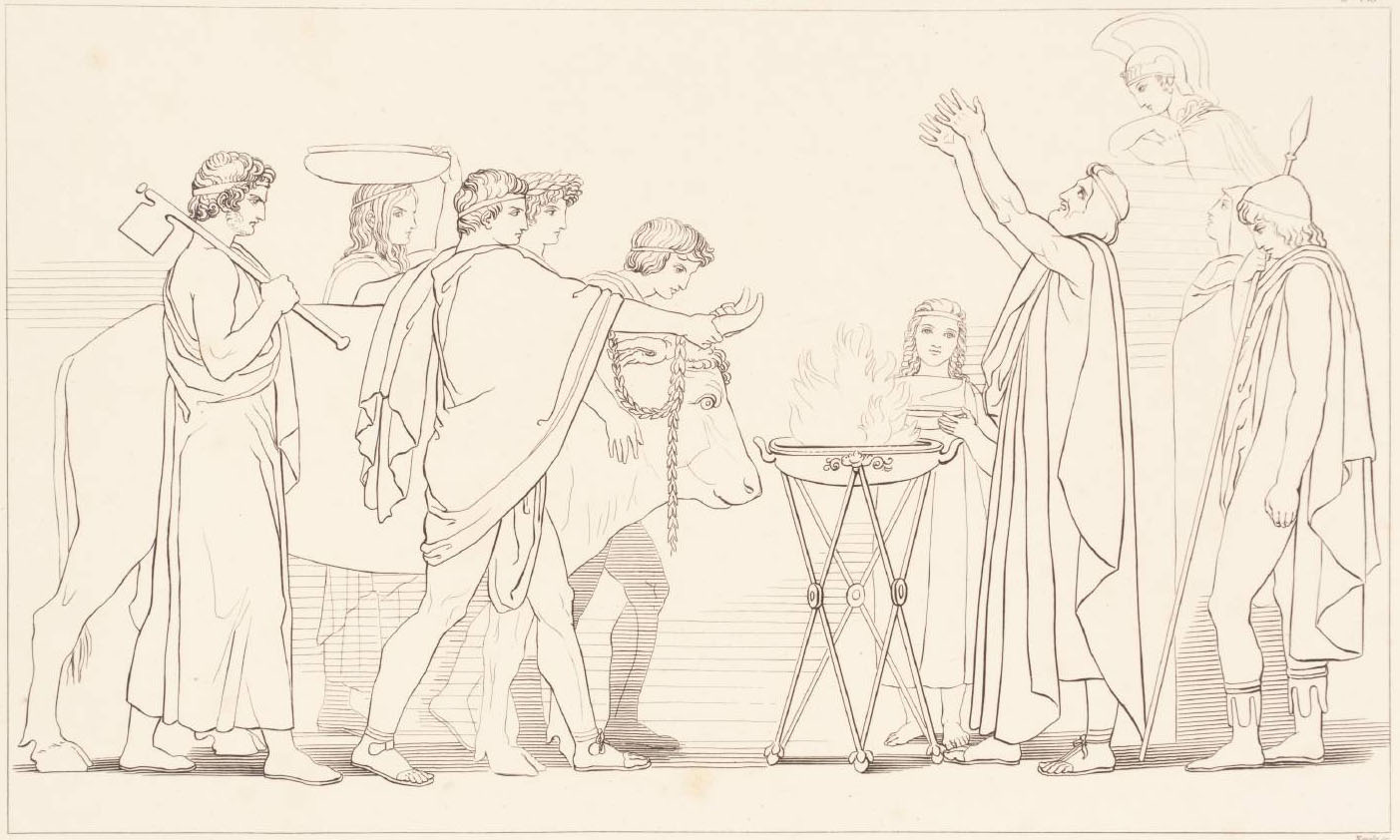

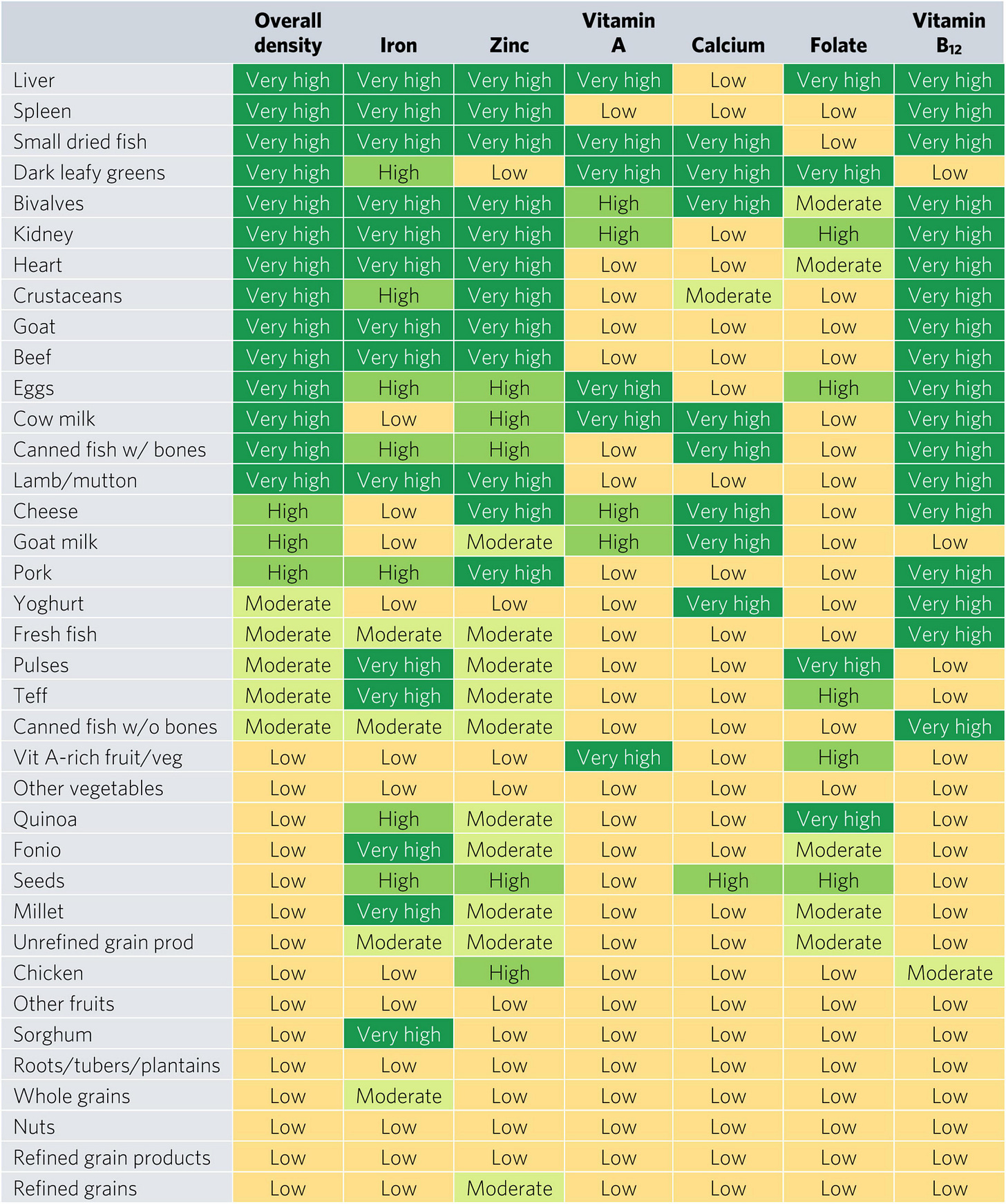
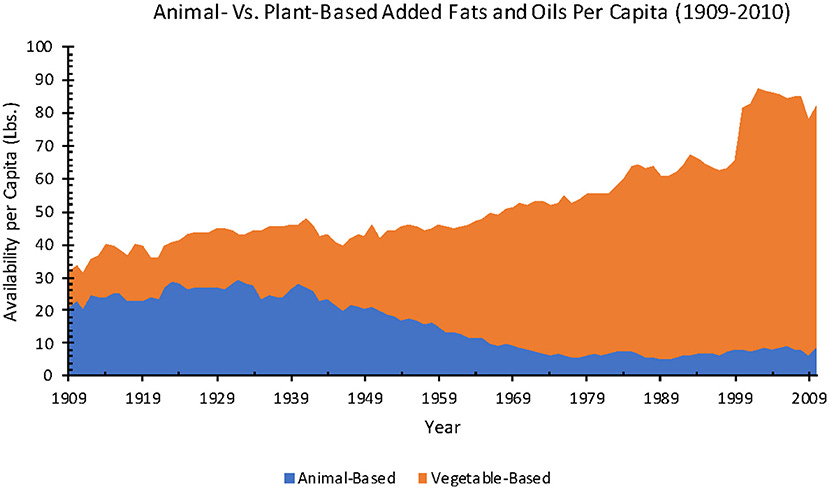
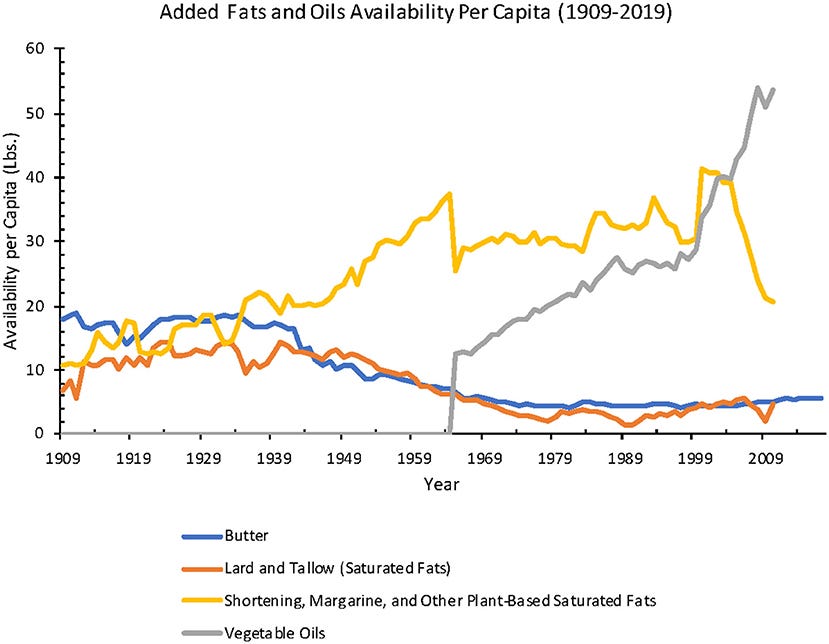

My brother-in-law is Danish and they have a word for that glorious phenomenon of butter so thick you leave tooth marks: tandsmør. Literally translates to toothbutter. That is the only way they eat bread there. More tandsmør in 2023!
Where do you put the squid in the table?